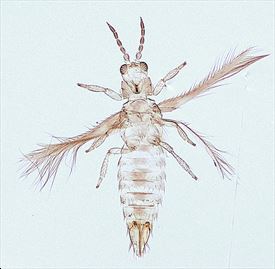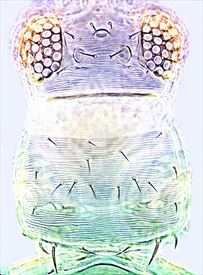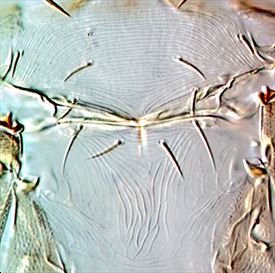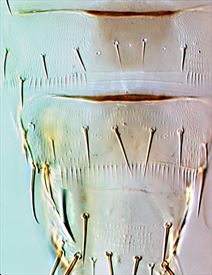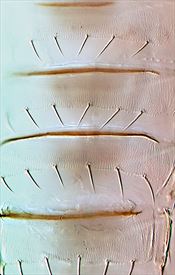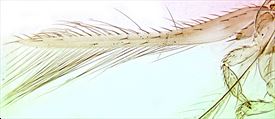Distinguishing features
Both sexes fully winged. Female yellow with brown marking medially on tergites III–VII, sternites without brown markings but antecostal ridges on tergites and sternites dark brown; fore wings usually strongly shaded but paler toward apex; antennal segment I pale, II shaded, III–VIII dark. Head about twice as wide as long, postocular and ocellar region closely striate; ocellar setae pair III arise between posterior ocelli, well behind tangent between their anterior margins; compound eyes with no ommatidia strongly pigmented; two pairs of post-ocellar setae as long as ocellar setae pair III. Pronotum closely striate, posteromarginal setae S2 30–35 microns, clearly longer than S1. Metanotal sculpture variable, usually transversely arcuate anteriorly, with irregular longitudinal reticulations or striations posteriorly; median pair of setae far behind anterior margin. Fore wing first vein with 3 setae on distal half, scale with 4 marginal setae; second vein with 2 (or 3) setae; posteromarginal fringe cilia all straight. Tergites III–V with bases of median setae usually closer together than length of these setae; tergal microtrichial fields with 3 discal setae; VIII with discal microtrichia present anteromedially, posteromarginal comb complete; tergite IX with discal microtrichia present posteromedially. Sternites with microtrichia extending across median area on posterior half.
Male similar to female in colour and sculpture, but smaller; tergite IX without drepanae, aedeagus apparently with no armature.
Related species
The genus Scirtothrips comprises almost 100 described species worldwide, with 21 species known from Australia, most of which are endemic to that continent. These species all have the lateral thirds of the abdominal tergites covered in closely spaced rows of fine microtrichia, and in many species the sternites also bear similar microtrichia. S. dorsalis is similar to S. aurantii from South Africa in having microtrichia extending fully across the sternites, unlike most other species of Scirtothrips. However, the males are readily distinguished by the hind femora lacking a setal comb in S. dorsalis, and whereas the fore wing cilia are straight in this species they are wavy in S. aurantii. Molecular differences have been demonstrated between populations of dorsalis, suggesting that a group of sibling species is involved (Hoddle et al., 2008; Dickey et al., 2015).
Biological data
This highly polyphagous thrips feeds and breeds on young leaves and immature fruits, and is sometimes a serious pest, although populations may show localised specificity.
Distribution data
Not recorded from New Zealand but considered a high risk potential invader, this species is widespread from Pakistan to Japan and Australia, and also introduced in Israel, the Carribean area, and parts of South America.
Family name
THRIPIDAE, THRIPINAE
Species name
Scirtothrips dorsalis Hood
Original name and synonyms
Scirtothrips dorsalis Hood, 1919: 90
Heliothrips minutissimus Bagnall, 1919: 260
Anaphothrips andreae Karny, 1925: 24
Neophysopus fragariae Girault, 1927: 1
Scirtothrips dorsalis var. padmae Ramakrishna, 1942: 169
References
Dickey AM, Kumar V, Hoddle MS, Funderburk JE, Morgan JK, Jara-Cavieres A (2015) The Scirtothrips dorsalis Species Complex: Endemism and Invasion in a Global Pest. PLoS ONE. 10(4): e0123747. doi:10.1371/journal.pone.0123747
Hoddle MS, Heraty JM, Rugman-Jones PF, Mound LA & Stouthamer R. (2008) Relationships among species of Scirtothrips (Thysanoptera: Thripidae) using molecular and morhphological data. Annals of the Entomological Society of America 101: 491–500.
Mound .A & Stiller M (2011) Species of the genus Scirtothrips from Africa (Thysanoptera, Thripidae). Zootaxa 2786: 51–61.

